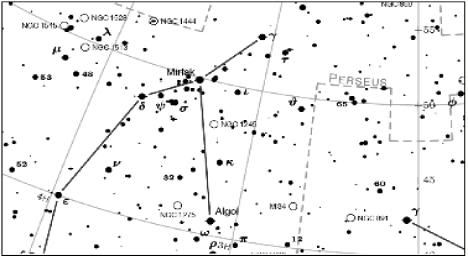
Algol, the second brightest star in the northern constellation Perseus, is a beautiful example of an eclipsing variable star. While the ancients were frightened by Algol… its name comes from the Arabic “al Ghul” meaning “The Demon”… it's a beautiful example of two stars revolving about each other in a rhythmic gravitational dance. And you can see it from your backyard. No telescope required.
• Algol lies some 90 light years from Earth. Like many stars, it's a binary: a hot blue-white star and a cooler yellow-orange star that revolve around each other. The stars are only 1/20 of the separation of the Earth and Sun so they revolve around each other quickly… once every 2.867 days.
• But unlike many binary stars, from our point of view on Earth the fainter cool star partly blocks the brighter hot star once per revolution. So the total brightness of the two stars appears to drop suddenly by roughly 70% every 2.867 days. And when the brighter star blocks the cool star, the total brightness drops again by a much smaller amount. The period of brightness variability is like clockwork.
• You can see this variability for yourself. Algol is easily visible in Perseus just east of Mirphak, the brightest star in the constellation. Compare the brightness against Mirphak or nearby gamma Andromedae.
• Eclipsing binary stars like Algol are more than a passing curiosity. They enable determination of stellar brightness and mass that help astronomers refine theories and mathematical models of how stars work.
- Quads, hailing from Grand Marsh Observatory atop Elk Castle Hill!